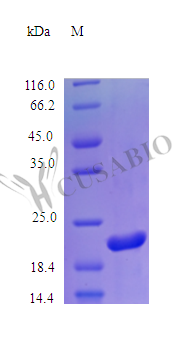The recombinant mouse Prolactin (PRL) is an active protein. It is synthesized in E. coli, involving the co-insertion of the gene of interest (30-226aa of mouse PRL) into an expression vector and subsequent transformation of it into E. coli cells. The cells are cultured to produce the protein, which is extracted by cell lysis. Purification is done using affinity chromatography. Its purity is assessed using SDS-PAGE, exceeding 98%. Its endotoxin content is less than 1.0 EU/μg as determined by the LAL method. Its activity has been determined by a cell proliferation assay.
Research indicates that PRL is involved in stress responses and can enhance the production of aldosterone and glucocorticoids in species such as rats, guinea pigs, mice, pigs, and humans [1]. In mice and rats, the PRL locus encodes a family of proteins with hormone and cytokine activities that contribute to the regulation of reproduction [2]. PRL concentrations in the circulation of mice follow a well-characterized pattern throughout pregnancy [3]. Studies have shown that PRL signaling mechanisms can be studied using models like Nb2 cells and mouse mammary gland explants, where PRL influences cell mitogenesis and milk product synthesis [4][5]. PRL also inhibits cell growth and mineralization in human osteoblasts [6].
PRL is implicated in mammary gland development and tumorigenesis, with PRL gene-disrupted mice showing arrested mammary gland development and reduced tumor growth [7]. The hormone activates signaling pathways in mammary tumor cell lines and normal mammary epithelial cells [8]. Additionally, PRL has been shown to stimulate cell proliferation through specific receptor activation and ion channel modulation [9].
References:
[1] A. Lefrançois‐Martinez, A. Blondet-Trichard, N. Binart, P. Val, C. Chambon, I. Sahut‐Barnolaet al., Transcriptional control of adrenal steroidogenesis, Journal of Biological Chemistry, vol. 286, no. 38, p. 32976-32985, 2011. https://doi.org/10.1074/jbc.m111.218016
[2] P. Bu, S. Alam, P. Dhakal, J. Vivian, & M. Soares, A prolactin family paralog regulates placental adaptations to a physiological stressor1, Biology of Reproduction, vol. 94, no. 5, 2016. https://doi.org/10.1095/biolreprod.115.138032
[3] S. Swartz, L. Ogren, & F. Talamantes, The sensitivity of prolactin secretion to dopamine changes during pregnancy in mice, Acta Endocrinologica, vol. 111, no. 4, p. 567-571, 1986. https://doi.org/10.1530/acta.0.1110567
[4] I. Camarillo and J. Rillema, Lovastatin inhibits prolactin-lnduced nb2 cell mitogenesis and milk product synthesis in mouse mammary gland explants, Experimental Biology and Medicine, vol. 216, no. 1, p. 98-103, 1997. https://doi.org/10.3181/00379727-216-44162
[5] K. Golden and J. Rillema, Effects of prolactin on galactosyl transferase and -lactalbumin mrna accumulation in mouse mammary gland explants, Experimental Biology and Medicine, vol. 209, no. 4, p. 392-396, 1995. https://doi.org/10.3181/00379727-209-43913
[6] D. Seriwatanachai, N. Krishnamra, & J. Leeuwen, Evidence for direct effects of prolactin on human osteoblasts: inhibition of cell growth and mineralization, Journal of Cellular Biochemistry, vol. 107, no. 4, p. 677-685, 2009. https://doi.org/10.1002/jcb.22161
[7] A. Vomachka, S. Pratt, J. Lockefeer, & N. Horseman, Prolactin gene-disruption arrests mammary gland development and retards t-antigen-induced tumor growth, Oncogene, vol. 19, no. 8, p. 1077-1084, 2000. https://doi.org/10.1038/sj.onc.1203348
[8] C. Clevenger, P. Furth, S. Hankinson, & L. Schuler, The role of prolactin in mammary carcinoma, Endocrine Reviews, vol. 24, no. 1, p. 1-27, 2003. https://doi.org/10.1210/er.2001-0036
[9] F. Coppenolle, R. Skryma, H. Ouadid-Ahidouch, C. Slomianny, M. Roudbaraki, P. Delcourtet al., Prolactin stimulates cell proliferation through a long form of prolactin receptor and k+ channel activation, Biochemical Journal, vol. 377, no. 3, p. 569-578, 2004. https://doi.org/10.1042/bj20030859




